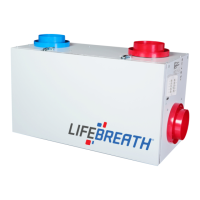
Do you have a question about the Lifebreath Air Purifier 155ECM and is the answer not in the manual?
| Model | 155ECM |
|---|---|
| Type | Air Purifier |
| Motor Type | ECM |
| Airflow Capacity | 155 CFM |
| Voltage | 120V |
Explains the function and core technology of Heat Recovery Ventilators (HRVs) and Energy Recovery Ventilators (ERVs).
Details the warranty coverage for Heat Recovery Ventilators (HRVs) and Energy Recovery Ventilators (ERVs).
Compares HRV and ERV technologies, focusing on heat and moisture transfer capabilities and optimal climate usage.
Provides guidance on cleaning the HRV/ERV core and the necessity of air filters for optimal performance and longevity.
Details airflow, temperature recovery, and effectiveness for the 95MAX model based on HVI certification.
Provides physical dimensions and port configurations for the 95MAX model, including port conversion details.
Details airflow, temperature recovery, and effectiveness for the 155MAX model based on HVI certification.
Provides physical dimensions and the performance fan curve for the 155MAX model.
Details airflow, temperature recovery, and effectiveness for the 155ECM model using an ECM motor.
Provides physical dimensions and the performance fan curve for the 155ECM model.
Details airflow, temperature recovery, and effectiveness for the 155MAX RX model based on HVI certification.
Provides physical dimensions and the performance fan curve for the 155MAX RX model.
Details airflow, temperature recovery, and effectiveness for the 200MAX model based on HVI certification.
Provides physical dimensions and the performance fan curve for the 200MAX model.
Details airflow, temperature recovery, and effectiveness for the 200MAX RX model based on HVI certification.
Provides physical dimensions and the performance fan curve for the 200MAX RX model.
Details airflow, temperature recovery, and effectiveness for the MAХТОР model based on HVI certification.
Provides physical dimensions and the performance fan curve for the MAХТОР model.
Details airflow, temperature recovery, and effectiveness for the 195DCS model based on HVI certification.
Provides physical dimensions and the performance fan curve for the 195DCS model.
Details airflow, temperature recovery, and effectiveness for the 300DCS model based on HVI certification.
Provides physical dimensions and the performance fan curve for the 300DCS model.
Details airflow, temperature recovery, and effectiveness for the 200ERV model based on HVI certification.
Provides physical dimensions and the performance fan curve for the 200ERV model.
Details airflow, temperature recovery, and effectiveness for the 200ERVD model based on HVI certification.
Provides physical dimensions and the performance fan curve for the 200ERVD model.
Covers removing the control pad, selecting operating modes (Standby, 20/40 OFF), and speed selection.
Explains the automatic defrost cycle that prevents core icing in cold weather conditions.
Defines key terms used in the manual, such as Dehumidistat, Standby Mode, and Thermistor.
Provides guidance on choosing the best operating mode (BEST, BETTER, GOOD) based on home ventilation needs.
Illustrates and explains the speed indicator lights, mode indicator light, and fan select button on the Control Pad.
Discusses the benefits of using main controls for home ventilation based on activity levels.
Details the function and connection of the dehumidistat for controlling indoor humidity levels.
Explains the Air Sentry™ sensor's role in detecting air contaminants and adjusting ventilation speed.
Introduces optional timers, including the Digital Electronic Timer and Crank Timer, for localized ventilation control.
Provides instructions on setting and using the dehumidistat to manage indoor humidity, especially during the heating season.
Guides on selecting an appropriate installation location and securely mounting the HRV/ERV unit using provided straps.
Outlines electrical requirements, including grounding, polarity confirmation, and recommended circuit protection.
Instructs on installing the condensate drain line and P-trap to manage moisture and prevent odor.
Describes the features of the weatherhoods, including bird screens, and guidelines for their placement.
Covers connecting flexible ducts to the unit and optimizing airflow with short, straight runs and appropriate duct sizes.
Discusses methods for supplying fresh air in homes without forced air, including grille selection and optional duct heaters.
Explains direct and indirect connection methods to furnace ductwork, emphasizing airflow balancing and electrical grounding.
Guides on installing return air ducts in high-moisture/odor areas and options for exhausting air via furnace return.
Recommends using balancing dampers and adjustable grilles like Techgrille™ for optimal air distribution.
Illustrates a system where stale air is drawn from specific rooms and fresh air is supplied to the furnace return.
Shows a direct connection of supply air stream to the furnace cold air return, with minimum separation requirements.
Depicts a return/return method for simplified installation, requiring furnace blower interlock or continuous run.
Illustrates connecting both HRV/ERV supply and exhaust streams to the furnace cold air return.
Depicts a supply/return method for simplified installation, recommending furnace blower interlock.
Shows connecting both HRV/ERV streams to the furnace cold air return and supply air side.
Illustrates a system with dedicated ducts for stale air exhaust and fresh air supply to main living areas.
Outlines the steps for field balancing an HRV/ERV using a Pitot tube and Magnehelic gauge for accurate airflow measurement.
Describes the components and connection of a Pitot tube with a Magnehelic gauge for measuring air velocity pressure.
Provides instructions for using balancing collars, including screw placement to avoid impeding damper operation.
Recommends monthly inspection of exterior hoods for blockages by leaves, grass, or snow to maintain airflow balance.
Details how to clean washable air filters, advising against using a dishwasher.
Guides on removing and cleaning the heat recovery core, emphasizing gentle washing and proper reassembly.
Covers cleaning the condensate drain line annually and the ductwork as needed to prevent blockages and maintain efficiency.
Advises on cleaning fan blades to prevent vibration and wiping down the cabinet interior for general upkeep.
Details monthly inspection of exterior hoods and quarterly cleaning of ERV air filters.
Provides steps for cleaning the ERV core (vacuum only) and fan blades to maintain performance and prevent vibration.
Covers cleaning the condensate drain line and ductwork annually for ERV units.
Lists common causes for poor airflow, such as blocked filters, obstructed cores, or improper balancing, and provides solutions.
Covers high and low humidity problems, their causes (dehumidistat settings, lifestyle, unit sizing), and recommended solutions.
Explains causes of frosting on HRV/ERV cores or condensation in ducts and offers solutions like checking vapor barriers and defrost systems.
Troubleshoots issues where the dehumidistat may not be operating correctly, checking connections and settings.
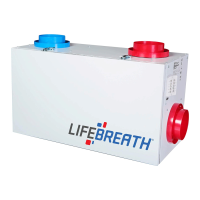
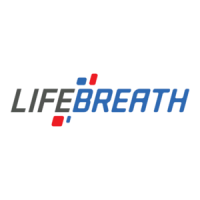
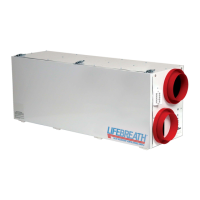


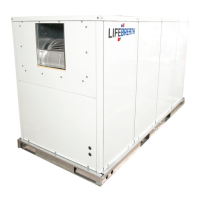
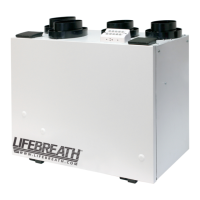



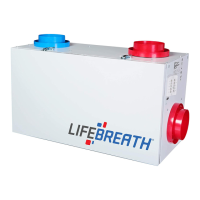

